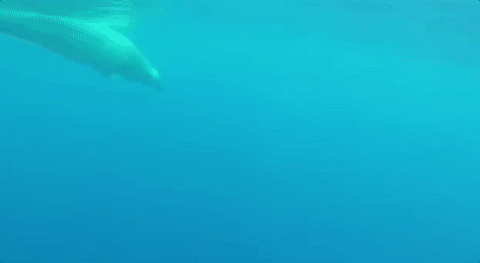One of the most elusive animals on the planet, the True’s beaked whale, has been filmed in the wild for the first time ever, scientists announced Tuesday.
The footage was taken by students on an educational trip in the Azores in 2013, but only released Tuesday as part of a new paper meant to shed light on a creature few people have ever seen in the wild.
Beaked whales, identifiable by their dolphin-like noses, spend the vast majority of their lives deep below the ocean’s surface, assisted by oblong, torpedo-shaped bodies.
Most of what scientists know of True’s beaked whales comes from beached carcasses, so the roughly 46-second video clip was a boon for scientists.
True’s beaked whales, which reach about 17 feet long, are believed to eat squid, and based on their cousins, likely dive thousands of feet below the surface for hours at a time on a single breath. Their fins can also be tucked into side pockets that further streamline their bodies.
“These are animals the size of elephants that we just can’t find. They’re a mystery,” Natacha Aguilar de Soto, who has studied the whales for 15 years, told the Washington Post.
The footage was published in the journal PeerJ, along with a detailed study on the elusive whales that culled data from a number of sources, including genetic analysis of other beaked whale species. The goal: to get a better idea of threats human activity may pose to mammals who are highly adapted to deep sea diving.
Source
The footage was taken by students on an educational trip in the Azores in 2013, but only released Tuesday as part of a new paper meant to shed light on a creature few people have ever seen in the wild.
Beaked whales, identifiable by their dolphin-like noses, spend the vast majority of their lives deep below the ocean’s surface, assisted by oblong, torpedo-shaped bodies.
Most of what scientists know of True’s beaked whales comes from beached carcasses, so the roughly 46-second video clip was a boon for scientists.
True’s beaked whales, which reach about 17 feet long, are believed to eat squid, and based on their cousins, likely dive thousands of feet below the surface for hours at a time on a single breath. Their fins can also be tucked into side pockets that further streamline their bodies.
“These are animals the size of elephants that we just can’t find. They’re a mystery,” Natacha Aguilar de Soto, who has studied the whales for 15 years, told the Washington Post.
The footage was published in the journal PeerJ, along with a detailed study on the elusive whales that culled data from a number of sources, including genetic analysis of other beaked whale species. The goal: to get a better idea of threats human activity may pose to mammals who are highly adapted to deep sea diving.
Source
VIDEO




Responses to "One Of The Most Rarely Seen Animals On Earth Was Captured On Film For The First Time"